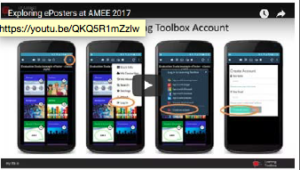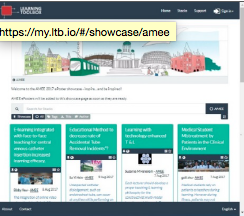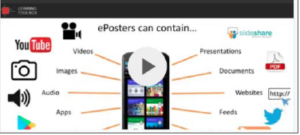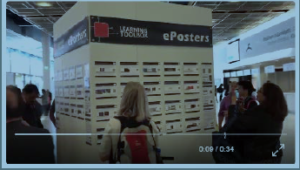Working further with the Learning Toolbox (LTB) – Part Two: LTB-based ePosters become success stories in European conferences
In my previous post I gave a progress report on our work with the Learning Toolbox (LTB) in the follow-up activities of our EU-funded Learning Layers project and its Construction pilot (2012 -2016). With this post I want to give visibility for the successful implementation of LTB as a tool for creating ePosters for large (European and international) conferences. This work has been led by the coordinator of the Learning Layers’ healthcare pilot, Tamsin Treasure-Jones and by the key developer of LTB, Raymond Elferink. Together with their support team they have pioneered with the use of LTB-based ePosters in the AMEE 2017 conference in Helsinki. I am pleased to publish their report on my blog. Many thanks to Tamsin, Ray and their team! From this point on I am using their text (slightly edited) and their pictures & links:
“Learning Toolbox – a transformative ePoster solution: AMEE 2017 as an example
Learning Toolbox as an ePoster solution is a spin-off initiative that emerged from the EU- funded Learning Layers research & development project. AMEE 2017 has been the pioneering ePoster client. AMEE is the very large (approx. 3,800 delegates) annual international conference of the Association of Medical Education (AMEE).
Overview of Learning Toolbox as the ePoster solution at AMEE 2017
These two short videos (which were created for the conference participants) provide an overview of the how the ePosters worked at AMEE.
https://youtu.be/6KUFHBhZGVs https://youtu.be/QKQ5R1mZzlw
In total we supported 80 ePosters (this included 3 which we created with the authors during the conference itself, as they had lost their paper posters in transit!). You can explore and interact with all the ePosters on our AMEE 2017 ePosters Showcase page https://my.ltb.io/#/showcase/amee:
What is novel about Learning Toolbox?
Underlying our approach are several educational aims to transform the way in which posters (and existing ePoster solutions) are used in conferences:
We wanted to move beyond a vision of ePosters as just an onscreen version of a paper poster (most ePoster solutions are effectively online PDFs with minimal interactivity). Learning Toolbox allows people to include a wide range of multimedia and interactive material in their ePoster including videos, surveys, presentations, web links and even apps.
Bridging between the physical and virtual worlds
We wanted to give the ePosters both a physical and virtual presence at the conference, and to allow easy bridging between these worlds. Existing ePoster platforms often only offer the ePosters online, so that they are easily overlooked in busy conferences. We used the mini-poster wall to actually give the ePosters a high profile (but small footprint) presence in the conference and a very easy way to move from the mini-poster to the ePosters.
Direct engagement & interaction between people
We wanted to support people engaging with the ePoster work and the ePoster authors (with traditional posters & ePosters this interaction with the author is only really possible during a very short timetabled presentation session). So Learning Toolbox also allows people to have discussions that are attached to the ePoster (viewable by all who interact with that ePoster) and the ePoster author can also send out messages to the ePoster. These exchanges can happen before, during & after the conference. Our educational aim is for this extra interactivity to help people to find and develop groups who have a shared interest in their research topic. This can be a particular issue at large conferences such as AMEE.
Bring your own device – ePosters in your pocket
We wanted to help people to feel very connected to the ePosters, to have them in their hands, in their pocket. You can also easily share an ePoster from one phone to another, allowing people to pass on the ePosters that interest them. Many traditional ePoster solutions rely heavily on expensive hardware (large screens or touchscreens). Learning Toolbox instead uses people’s own devices, supporting a more personalised experience.
Life beyond the conference
We wanted people to be able to take home the ePoster, to actually have them as a long-term learning resource that could be used by the ePoster author and those who had an interest in their topic. Learning Toolbox allows conference attendees to favourite and easily take home ePosters with them on their phone and it allows the ePoster author to add to and update their ePoster following the discussions at the conference”
– – –
This was the report of our pioneering team in AMEE 2017. If you want to have more information on the way the participants prepared themselves for the conference and how the ePosters were used, I would recommend you to follow the tweets of Tamsin Treasure-Jones @tamsinttj. And if you want to get more information, how to use ePosters in your conferences, contact Raymond Elferink and his team support [at] stack [dot] services
As I have heard it from Gilbert Peffer, who was also involved in that exercise, also other conferences and support organisations are interested to use ePosters. We hope that also our conference organisers in the field of Vocational Education and Training (VET) research will follow their example in due time.
More blogs to come …




